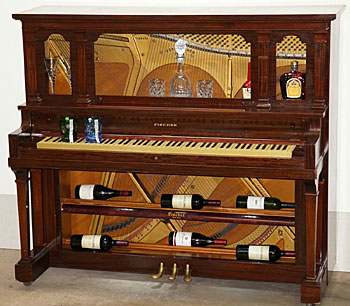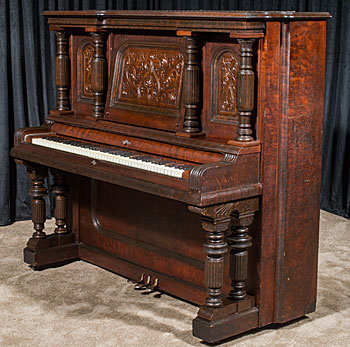Pity the poor parlour piano. If you have one that you want to sell, you know what I mean; you literally can’t give them away. Once the pride of every middle-class home, a staple in church basements and bars everywhere, most upright pianos are now worth more as scrap than as functioning music machines.
No wonder. Pianos are heavy, fragile, need constant maintenance and, unlike most instruments, deteriorate with age. The parlour piano’s usefulness has been replaced by much more convenient, functional and inexpensive electronic machines that sound quite good. The grand piano however still rules on the concert stage because you can’t fake its sound, how it responds to the player’s fingers or how it looks; it really is a mechanical marvel that electronics cannot yet replicate.
The piano was invented in Italy by Bartolomeo Cristofori around 1700. He was an expert harpsichord builder who realized musicians wanted to be able to control the volume of the sound by how they hit the keys and the harpsichord could never do that because the strings were plucked. Hammered string instruments, such as the dulcimer and the clavichord, had been around for a long time but they weren’t loud enough for an orchestral setting. Cristofori came up with a mechanical action where a player hitting a key would cause a hammer to hit the right string with the same force and then immediately be available to do it again. He hooked the whole thing up to a resonant sound board and the piano, or un cimbalo di cipresso di piano e forte ("a keyboard of cypress with soft and loud") as he called it, was born. It met with good reviews and makers all over Europe started putting out their own versions (copyright only applied to books at the time).
Reportedly J.S. Bach was shown one in 1730 but didn’t really like it, he stuck with the harpsichord. Improvements were made and Mozart started using crude, five-octave pianos about 25 years later but it wasn’t until the next century that Beethoven immortalized what we now know as the modern, 88 key grand piano.
Beethoven, Haydn and other great composers wrote lots of music for very accomplished players; they wanted to show their virtuosity and pushed the piano to its limits, so skilled makers kept improving it. The piano became the king of instruments; whole orchestral pieces were built around it.
The first true upright piano appeared around 1800. It was built by John Hawkins, and Englishman living in Philadelphia. Square and upright pianos had been built before but Hawkins’ innovation was he had the strings run from the floor, not out from the keyboard so his piano was much more compact and could be built relatively cheaply.
Unfortunately he didn’t profit much from his invention, another maker, Robert Warnum patented what he called the cottage piano in 1809. The Industrial Revolution allowed many more makers to start producing pianos in great quantities and it generated a lot of middle class families who wanted to own one.
The upright doesn’t sound as good as a grand, the keyboard action isn’t as responsive and its compressed size means it can’t be tuned as accurately, it has to be tweaked, or tempered, to fool the ear but it is relatively cheap, reliable, will fit in a small room and you can play almost anything on it. Before long the piano went from being just for elite, serious musicians to an instrument almost anybody could own and learn to play.
This democratization of the piano had a profound effect on our popular music. Ragtime, the first North American popular music craze in the early 1900s, was designed for the piano. Its popularity was spread by sheet music that people took home and played on their own pianos.
The piano keyboard is perfect for music writers. Even those who couldn’t play very well or read complex scores could pick out and play around with a melody and then write it down.
Helped by new printing technology and better copyright laws, popular music writers, centred in New York City in what was called Tin Pan Alley, started cranking out ditties for all the amateur piano players out there.
A lot of people credit or blame the recording industry for propagating silly love songs and developing the KISS (keep it simple, stupid) paradigm but Tin Pan Alley writers, pandering to piano players entertaining themselves at home, deliberately made songs that were catchy and easy to play. They defined the rules for pop music for the next century.
Not all non-classical music was simple though, jazz, which developed from ragtime, became very complex and helped re-define our notion of what is harmonic, or pleasing to the ear, and what is not. Then there was boogie-woogie, stride and honky-tonk and a myriad of other styles all developed on and for the piano. It’s hard to imagine any kind of western (i.e. European-based) music without the piano.
The early 1900s were what is loosely called the Golden Age of the Piano which of course means that it soon began to fade, at least on the popular side of things. The Great Depression didn’t help, then World War Two made materials scarce and the radio and phonograph were taking over as home entertainment. Worst of all there was more and more electronic amplification in popular music, the acoustic piano couldn’t keep up so even professional players were looking for alternatives
The first electric pianos appeared in the 1930s. They were still essentially mechanical devices with hammers but instead of long strings they used shorter strings or metal reeds and the cumbersome soundboard was replaced by electric pickups, similar to an electric guitar. They were first developed as a teaching tool but soon models were made specifically for the stage because they were easier to move around and tended to stay in tune.
 They didn’t really sound like a piano though. That was fine in some cases; Ray Charles used one to great effect on his recording of What’d I Say in 1959, but later electronic pianos used recorded samples of real piano sounds instead of hammers and strings. They were even lighter and more reliable and they sounded, well good enough. The upright piano, which was a compromise in the first place, just couldn’t compete.
They didn’t really sound like a piano though. That was fine in some cases; Ray Charles used one to great effect on his recording of What’d I Say in 1959, but later electronic pianos used recorded samples of real piano sounds instead of hammers and strings. They were even lighter and more reliable and they sounded, well good enough. The upright piano, which was a compromise in the first place, just couldn’t compete.
Of course people still play them, it’s just that there are so many around, and most of them are in need of repair or outright restoration, that only the best have any value today. That doesn’t necessarily mean the best sounding instruments; fine cabinetry and a good name usually trump sound. A plain piano is just not as exciting and a fancy one.
If you have one to sell and it’s a Steinway or Baldwin or other major manufacturer and has a fancy carved cabinet and is in good condition, you still have a chance. Otherwise, if you can find someone who will take it for free, go for it.
It is a buyers’ market but the buyer should still beware; if you are not an expert then get one to check out any piano before you buy it. A hard-to-see crack in the soundboard or casting could be irreparable.
Otherwise, I’m all for re-purposing, these once-proud beauties should not be taken to the dump if there is any life left in their cabinets or mechanical parts, all it takes is some imagination.

